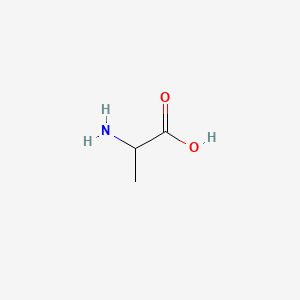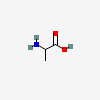DL-Alanine
- DL-ALANINE
- 302-72-7
- alanine
- 2-Aminopropanoic acid
- DL-2-Aminopropionic acid
- Create:2004-09-16
- Modify:2025-01-04


- Abufène
- Alanine
- Alanine, L Isomer
- Alanine, L-Isomer
- L Alanine
- L-Alanine
- L-Isomer Alanine
- DL-ALANINE
- 302-72-7
- alanine
- 2-Aminopropanoic acid
- DL-2-Aminopropionic acid
- Alanine, DL-
- DL-alpha-Alanine
- D,L-Alanine
- (R,S)-Alanine
- DL-2-Aminopropanoic acid
- (+-)-Alanine
- MFCD00064408
- (RS)-2-Aminopropionsaeure
- DL-alpha-Aminopropionic acid
- (+-)-2-Aminopropionic acid
- alanin
- NSC 7602
- alanina
- dl-.alpha.-Aminopropionic acid
- (+/-)-2-Aminopropionic acid
- DL-.alpha.-Alanine
- AI3-08908
- 2-amino-propionic acid
- (.+/-.)-Alanine
- Propanoic acid, 2-amino-
- Alanine-1,2,3-13C3
- CHEBI:16449
- NSC7602
- 1FU7983T0U
- L-ALANINE-2-13C-15N
- NSC-7602
- E639
- H-DL-Ala-OH
- L-ALANINE (D7)
- l alanine
- .alpha.-Alanine
- L-Isomer alanine
- Alanine, L isomer
- Alanine, L-isomer
- L-Alanine-C2
- L-.alpha.-Alanine
- NSC-206315
- .alpha.-Aminopropionic acid
- (+/-)-Alanine
- EINECS 206-126-4
- L-.alpha.-Aminopropionic acid
- UNII-1FU7983T0U
- CCRIS 8596
- L-ALANINE (3-13C)
- DL-ALANINE (2-13C)
- Alanine #
- 285977-86-8
- (DL)-Alanine
- DL-Ala
- L(+)-Alanine
- ALANINE, .alpha.
- ALANINE, ALPHA
- 2-Amino propanoic acid
- (.+-.)-Alanine
- L-|A-Aminopropionic acid
- DL-ALANINE [FCC]
- bmse000282
- L-ALANINE EXTRA PURE
- DL-Aminopropionic Acid,(S)
- ALANINE DL-FORM [MI]
- CHEMBL12198
- DL-Alanine, FCC, >=99%
- DTXSID6031255
- FEMA NO. 3818
- DL-Alanine, >=99% (HPLC)
- BCP26675
- BCP31944
- HY-N2362
- DL-Alanine, >=99%, FCC, FG
- NSC158286
- NSC206315
- STK125106
- AKOS000119663
- AKOS016039389
- AKOS024264604
- (+/-)-2-AMINOPROPANOIC ACID
- AB02601
- (R)-(-)-2-AMINOPROPIONIC ACID
- SY002277
- SY005245
- DB-029692
- DB-048512
- A0178
- CS-0022544
- DL-Alanine, Vetec(TM) reagent grade, 98%
- NS00002090
- EN300-18224
- C01401
- D72543
- (S)-2-Aminopropionic acid;L-a-Aminopropionic acid
- L001042
- D-2-Aminopropionic acid; (R)-2-Aminopropionic acid
- Q-101653
- BRD-A33317514-001-01-3
- H-D-Ala-OH;(R)-Alanine;(2R)-2-aminopropanoic acid
- Q27101911
- Z57396987
- F1652-0639
- 915B7CC8-31B0-4478-904B-D54B7ECC1E4D
- (a-D-Mannosyl)7-b-D-mannosyl-diacetylchitobiosyl-L-asparagine, isoform a (protein)
- (alpha-D-mannosyl)7-beta-D-mannosyl-diacetylchitobiosyl-L-asparagine, isoform A (protein)
44.0 99.99
18.0 25.52
28.0 14.89
42.0 12.09
15.0 5.83
116.0 100
147.0 19.12
117.0 12.41
100.0 7.01
103.0 4.60
90.056 100
44.049 60.96
44.0486 100
44.9959 15.03
42.0333 9.51
43.0397 2.64
55.0149 1.78
90.056 999
44.049 609
44 999
90 723
43 289
89 164
44 999
18 255
28 149
42 121
15 58
Use (kg; approx.) in Germany (2009): >25000
Consumption (g per capita; approx.) in Germany (2009): 0.305
Calculated removal (%): 92.1
Information on 33 consumer products that contain Alanine in the following categories is provided:
• Personal Care
Not Classified
Reported as not meeting GHS hazard criteria by 258 of 261 companies (only 1.1% companies provided GHS information). For more detailed information, please visit ECHA C&L website.
Aggregated GHS information provided per 261 reports by companies from 4 notifications to the ECHA C&L Inventory.
Reported as not meeting GHS hazard criteria per 258 of 261 reports by companies. For more detailed information, please visit ECHA C&L website.
There are 3 notifications provided by 3 of 261 reports by companies with hazard statement code(s).
Information may vary between notifications depending on impurities, additives, and other factors. The percentage value in parenthesis indicates the notified classification ratio from companies that provide hazard codes. Only hazard codes with percentage values above 10% are shown.
Status: Active Update: 20-04-2021 https://echa.europa.eu/registration-dossier/-/registered-dossier/24843
Status: Active Update: 26-09-2022 https://echa.europa.eu/registration-dossier/-/registered-dossier/33117
IMAP assessments - DL-Alanine: Environment tier I assessment
Evaluation - Chemicals that are unlikely to require further regulation to manage risks to human health
The Merck Manual, 17th ed. Mark H. Beers, MD, Robert Berkow, MD, eds. Whitehouse Station, NJ: Merck Research Labs, 1999.
Patents are available for this chemical structure:
https://patentscope.wipo.int/search/en/result.jsf?inchikey=QNAYBMKLOCPYGJ-UHFFFAOYSA-N
- Australian Industrial Chemicals Introduction Scheme (AICIS)
- CAS Common ChemistryLICENSEThe data from CAS Common Chemistry is provided under a CC-BY-NC 4.0 license, unless otherwise stated.https://creativecommons.org/licenses/by-nc/4.0/Poly(DL-alanine)https://commonchemistry.cas.org/detail?cas_rn=25281-63-4
- ChemIDplusChemIDplus Chemical Information Classificationhttps://pubchem.ncbi.nlm.nih.gov/source/ChemIDplus
- DrugBankLICENSECreative Common's Attribution-NonCommercial 4.0 International License (http://creativecommons.org/licenses/by-nc/4.0/legalcode)https://www.drugbank.ca/legal/terms_of_use
- DTP/NCILICENSEUnless otherwise indicated, all text within NCI products is free of copyright and may be reused without our permission. Credit the National Cancer Institute as the source.https://www.cancer.gov/policies/copyright-reuse
- EPA Chemicals under the TSCAEPA TSCA Classificationhttps://www.epa.gov/tsca-inventory
- EPA DSSToxCompTox Chemicals Dashboard Chemical Listshttps://comptox.epa.gov/dashboard/chemical-lists/
- European Chemicals Agency (ECHA)LICENSEUse of the information, documents and data from the ECHA website is subject to the terms and conditions of this Legal Notice, and subject to other binding limitations provided for under applicable law, the information, documents and data made available on the ECHA website may be reproduced, distributed and/or used, totally or in part, for non-commercial purposes provided that ECHA is acknowledged as the source: "Source: European Chemicals Agency, http://echa.europa.eu/". Such acknowledgement must be included in each copy of the material. ECHA permits and encourages organisations and individuals to create links to the ECHA website under the following cumulative conditions: Links can only be made to webpages that provide a link to the Legal Notice page.https://echa.europa.eu/web/guest/legal-noticeDL-alaninehttps://chem.echa.europa.eu/100.005.571DL-alanine (EC: 206-126-4)https://echa.europa.eu/information-on-chemicals/cl-inventory-database/-/discli/details/29921
- FDA Global Substance Registration System (GSRS)LICENSEUnless otherwise noted, the contents of the FDA website (www.fda.gov), both text and graphics, are not copyrighted. They are in the public domain and may be republished, reprinted and otherwise used freely by anyone without the need to obtain permission from FDA. Credit to the U.S. Food and Drug Administration as the source is appreciated but not required.https://www.fda.gov/about-fda/about-website/website-policies#linking
- Human Metabolome Database (HMDB)LICENSEHMDB is offered to the public as a freely available resource. Use and re-distribution of the data, in whole or in part, for commercial purposes requires explicit permission of the authors and explicit acknowledgment of the source material (HMDB) and the original publication (see the HMDB citing page). We ask that users who download significant portions of the database cite the HMDB paper in any resulting publications.http://www.hmdb.ca/citing(alpha-D-mannosyl)7-beta-D-mannosyl-diacetylchitobiosyl-L-asparagine, isoform A (protein)http://www.hmdb.ca/metabolites/HMDB0062251HMDB0062251_cms_29657https://hmdb.ca/metabolites/HMDB0062251#spectra
- New Zealand Environmental Protection Authority (EPA)LICENSEThis work is licensed under the Creative Commons Attribution-ShareAlike 4.0 International licence.https://www.epa.govt.nz/about-this-site/general-copyright-statement/
- ChEBI
- LOTUS - the natural products occurrence databaseLICENSEThe code for LOTUS is released under the GNU General Public License v3.0.https://lotus.nprod.net/DL-Alaninehttps://www.wikidata.org/wiki/Q27101911LOTUS Treehttps://lotus.naturalproducts.net/
- NCI Thesaurus (NCIt)LICENSEUnless otherwise indicated, all text within NCI products is free of copyright and may be reused without our permission. Credit the National Cancer Institute as the source.https://www.cancer.gov/policies/copyright-reuseNCI Thesaurushttps://ncit.nci.nih.gov
- Open TargetsLICENSEDatasets generated by the Open Targets Platform are freely available for download.https://platform-docs.opentargets.org/licence
- ChEMBLLICENSEAccess to the web interface of ChEMBL is made under the EBI's Terms of Use (http://www.ebi.ac.uk/Information/termsofuse.html). The ChEMBL data is made available on a Creative Commons Attribution-Share Alike 3.0 Unported License (http://creativecommons.org/licenses/by-sa/3.0/).http://www.ebi.ac.uk/Information/termsofuse.html
- ClinicalTrials.govLICENSEThe ClinicalTrials.gov data carry an international copyright outside the United States and its Territories or Possessions. Some ClinicalTrials.gov data may be subject to the copyright of third parties; you should consult these entities for any additional terms of use.https://clinicaltrials.gov/ct2/about-site/terms-conditions#Use
- Consumer Product Information Database (CPID)LICENSECopyright (c) 2024 DeLima Associates. All rights reserved. Unless otherwise indicated, all materials from CPID are copyrighted by DeLima Associates. No part of these materials, either text or image may be used for any purpose other than for personal use. Therefore, reproduction, modification, storage in a retrieval system or retransmission, in any form or by any means, electronic, mechanical or otherwise, for reasons other than personal use, is strictly prohibited without prior written permission.https://www.whatsinproducts.com/contents/view/1/6Consumer Products Category Classificationhttps://www.whatsinproducts.com/
- Cosmetic Ingredient Review (CIR)
- EPA Chemical and Products Database (CPDat)EPA CPDat Classificationhttps://www.epa.gov/chemical-research/chemical-and-products-database-cpdat
- Haz-Map, Information on Hazardous Chemicals and Occupational DiseasesLICENSECopyright (c) 2022 Haz-Map(R). All rights reserved. Unless otherwise indicated, all materials from Haz-Map are copyrighted by Haz-Map(R). No part of these materials, either text or image may be used for any purpose other than for personal use. Therefore, reproduction, modification, storage in a retrieval system or retransmission, in any form or by any means, electronic, mechanical or otherwise, for reasons other than personal use, is strictly prohibited without prior written permission.https://haz-map.com/AboutDL-Alaninehttps://haz-map.com/Agents/13948
- NORMAN Suspect List ExchangeLICENSEData: CC-BY 4.0; Code (hosted by ECI, LCSB): Artistic-2.0https://creativecommons.org/licenses/by/4.0/ALANINENORMAN Suspect List Exchange Classificationhttps://www.norman-network.com/nds/SLE/
- DailyMed
- Joint FAO/WHO Expert Committee on Food Additives (JECFA)LICENSEPermission from WHO is not required for the use of WHO materials issued under the Creative Commons Attribution-NonCommercial-ShareAlike 3.0 Intergovernmental Organization (CC BY-NC-SA 3.0 IGO) licence.https://www.who.int/about/policies/publishing/copyright
- IUPAC Digitized pKa Datasetpropanoic acid, 2-amino-https://github.com/IUPAC/Dissociation-Constants
- EU Clinical Trials Register
- EU Food Improvement Agents
- FDA Substances Added to FoodLICENSEUnless otherwise noted, the contents of the FDA website (www.fda.gov), both text and graphics, are not copyrighted. They are in the public domain and may be republished, reprinted and otherwise used freely by anyone without the need to obtain permission from FDA. Credit to the U.S. Food and Drug Administration as the source is appreciated but not required.https://www.fda.gov/about-fda/about-website/website-policies#linking
- Flavor and Extract Manufacturers Association (FEMA)
- MassBank of North America (MoNA)LICENSEThe content of the MoNA database is licensed under CC BY 4.0.https://mona.fiehnlab.ucdavis.edu/documentation/license
- NIST Mass Spectrometry Data CenterLICENSEData covered by the Standard Reference Data Act of 1968 as amended.https://www.nist.gov/srd/public-lawdl-Alaninehttp://www.nist.gov/srd/nist1a.cfm
- SpectraBase2-AMINOPROPIONIC ACIDhttps://spectrabase.com/spectrum/Ir7eFcH7vcO2-Aminopropionic acidhttps://spectrabase.com/spectrum/9368KOw7y4dD,L-Alaninehttps://spectrabase.com/spectrum/53AEhjTPst8D,L-Alaninehttps://spectrabase.com/spectrum/Jw0fsTRoYqO
- Japan Chemical Substance Dictionary (Nikkaji)
- KEGGLICENSEAcademic users may freely use the KEGG website. Non-academic use of KEGG generally requires a commercial licensehttps://www.kegg.jp/kegg/legal.htmlRisk category of Japanese OTC drugshttp://www.genome.jp/kegg-bin/get_htext?br08312.keg
- Natural Product Activity and Species Source (NPASS)
- MassBank Europe
- Metabolomics Workbench
- National Drug Code (NDC) DirectoryLICENSEUnless otherwise noted, the contents of the FDA website (www.fda.gov), both text and graphics, are not copyrighted. They are in the public domain and may be republished, reprinted and otherwise used freely by anyone without the need to obtain permission from FDA. Credit to the U.S. Food and Drug Administration as the source is appreciated but not required.https://www.fda.gov/about-fda/about-website/website-policies#linking
- NIPH Clinical Trials Search of Japan
- NLM RxNorm TerminologyLICENSEThe RxNorm Terminology is created by the National Library of Medicine (NLM) and is in the public domain and may be republished, reprinted and otherwise used freely by anyone without the need to obtain permission from NLM. Credit to the U.S. National Library of Medicine as the source is appreciated but not required. The full RxNorm dataset requires a free license.https://www.nlm.nih.gov/research/umls/rxnorm/docs/termsofservice.html
- Springer Nature
- Thieme ChemistryLICENSEThe Thieme Chemistry contribution within PubChem is provided under a CC-BY-NC-ND 4.0 license, unless otherwise stated.https://creativecommons.org/licenses/by-nc-nd/4.0/
- WikidataDL-alaninehttps://www.wikidata.org/wiki/Q27101911
- Wiley
- Medical Subject Headings (MeSH)LICENSEWorks produced by the U.S. government are not subject to copyright protection in the United States. Any such works found on National Library of Medicine (NLM) Web sites may be freely used or reproduced without permission in the U.S.https://www.nlm.nih.gov/copyright.html
- PubChem
- GHS Classification (UNECE)GHS Classification Treehttp://www.unece.org/trans/danger/publi/ghs/ghs_welcome_e.html
- EPA Substance Registry ServicesEPA SRS List Classificationhttps://sor.epa.gov/sor_internet/registry/substreg/LandingPage.do
- MolGenieMolGenie Organic Chemistry Ontologyhttps://github.com/MolGenie/ontology/
- PATENTSCOPE (WIPO)SID 403031487https://pubchem.ncbi.nlm.nih.gov/substance/403031487











